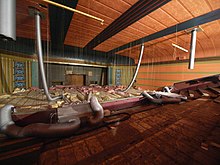
Galashiels is a town in the Scottish Borders with a population of around 12,600. Its name is often colloquially shortened to "Gala". The town is a major commercial centre for the Borders region with extensive history in the textile industry. Galashiels is the location of Heriot-Watt University's School of Textiles and Design.

Portobello is a coastal suburb of Edinburgh in eastern central Scotland. It lies 3 miles (5 km) east of the city centre, facing the Firth of Forth, between the suburbs of Joppa and Craigentinny. Although historically it was a town in its own right, it is officially a residential suburb of Edinburgh. The promenade fronts onto a wide sandy beach.

The Rex is a cinema in the town of Berkhamsted, Hertfordshire, England. Designed in the art deco style by David Evelyn Nye in 1936, the cinema opened to the public in 1938. After 50 years of service, the cinema closed in 1988 and became derelict. The building was listed Grade II by English Heritage, and following a campaign to save the Rex by a local entrepreneur, the cinema re-opened to the public in 2004.
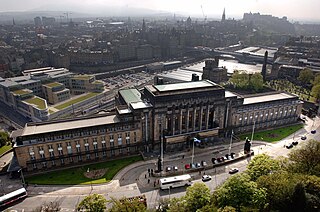
St Andrew's House (SAH), on the southern flank of Calton Hill in central Edinburgh, is the headquarters building of the Scottish Government.

The Fox Theater in Spokane, Washington is a 1931 Art Deco movie theater that now serves as a performing arts venue and home of the Spokane Symphony. It was designed by architect Robert C. Reamer, notable for his design of the Old Faithful Inn in Yellowstone National Park. It was part of the Fox Film Corporation Empire founded by studio mogul William Fox. The theater opened September 3, 1931 and showed films continuously until it closed September 21, 2000 after an engagement of the movie Gladiator starring Russell Crowe.

Gaumont State Cinema is a Grade II* listed Art Deco theatre located in Kilburn, a district in northwest London.
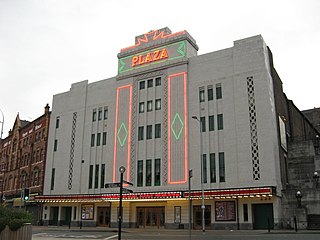
The Plaza is a Grade II* listed art deco single-screen cinema and theatre in Mersey Square, Stockport, England. It opened in 1932, its construction having involved the excavation of the sandstone cliff behind it. After an initial closure in 1966 and a subsequent period in use as a bingo hall by Rank Leiure, it has now been restored as a cinema and theatre, showing films and staging live shows.
The Boyd Theatre was a 1920s era movie palace in Center City Philadelphia, Pennsylvania. It operated as a movie theater for 74 years, operating under the name Sameric as part of the United Artists theater chain, before closing in 2002. The theater was the last of its kind in downtown Philadelphia, a remnant of an era of theaters and movie palaces that stretched along Market and Chestnut Streets. The Boyd's auditorium was demolished in the Spring of 2015 by its current owner Pearl Properties, which plans to replace it with a 24 story residential tower.
The architecture of Mumbai blends Gothic, Victorian, Art Deco, Indo-Saracenic & Contemporary architectural styles. Many buildings, structures and historical monuments remain from the colonial era. Mumbai, after Miami, has the second largest number of Art Deco buildings in the world.

The Dominion Cinema is an independent Streamline Moderne cinema located in the Morningside area of Edinburgh, Scotland. The company was incorporated by William Cameron, on 13 May 1937 when he bought the land in Newbattle Terrace. The cinema was opened on 31 January 1938 originally seating 1300. It was designed by architect Thomas Bowhill Gibson in an Art Deco style.
Aberdeen has been the host of several theatres and concert halls through history. Some of them have been converted or destroyed over the years.

John Stanley Coombe Beard FRIBA, known professionally as J. Stanley Beard, was an English architect known for designing many cinemas in and around London.
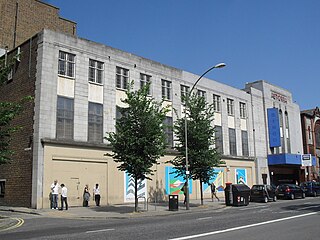
The Astoria Theatre was a former cinema in Brighton, part of the English coastal city of Brighton and Hove. Built in 1933 in the Art Deco style for a local entertainment magnate who opened one of Brighton's first cinemas many years earlier, it was the first and most important expansion of the Astoria brand outside London. It initially struggled against the town's other "super-cinemas", but enjoyed a period of success in the 1950s and 1960s before rapid decline set in, culminating in its closure in 1977.

Towers Cinema was a former cinema in Hornchurch, England. It was built in 1935 on part of the former Grey Towers estate and was noted for its Art Deco style of architecture. From 1973 it was used as a bingo hall until it closed in 2015. Despite the efforts of a local campaign to preserve the structure and to have it listed by Historic England, the building was demolished to make way for a Lidl supermarket.
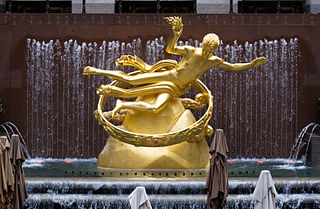
The Art Deco style, which originated in France just before World War I, had an important impact on architecture and design in the United States in the 1920s and 1930s. The most notable examples are the skyscrapers of New York City, including the Empire State Building, Chrysler Building, and Rockefeller Center. It combined modern aesthetics, fine craftsmanship, and expensive materials, and became the symbol of luxury and modernity. While rarely used in residences, it was frequently used for office buildings, government buildings, train stations, movie theaters, diners and department stores. It also was frequently used in furniture, and in the design of automobiles, ocean liners, and everyday objects such as toasters and radio sets.

The Embassy Cinema is a former cinema in the town of Chadwell Heath, Greater London. It was once known, among locals, as The Gaumont. It was designed in an art deco style, with a streamline moderne interior, by Harry Weston in 1934. The building is situated on the border of Redbridge and Barking & Dagenham, in the Chadwell Heath District Centre. The cinema closed in 1966 and became a Bingo Hall. In 2015, following the closure of the Bingo Hall, it was then used as a wedding hall/banqueting suite. The building was listed as an Asset of Community Value by the 'Chadwell Heath South Residents' Association' in August 2017 and is currently the focus of a major cinema restoration project.

Portobello Power Station was a coal-fired power station in Portobello, Edinburgh which was built in 1923 by the Edinburgh Corporation in order to cope with the increasing demand for electricity in the city. Although originally intended to be built in 1913, its construction was delayed because of the First World War, and it was formally opened by George V ten years later. Its electricity was used to power Edinburgh and the surrounding region while waste heat warmed the water of Portobello Open Air Pool.
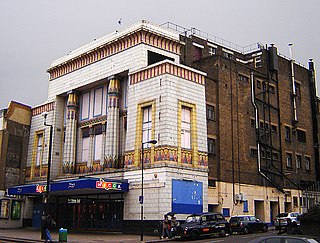
The former Carlton Cinema is an Art deco Grade II* listed building, located at 161–169 Essex Road, Islington, London. It was completed in 1930 as a cine-variety theatre with a capacity of 2,226 seats.

The Rural Bank Building was a landmark bank and commercial building on a block bounded by Martin Place, Elizabeth Street, and Phillip Street in the central business district of Sydney, Australia. Completed in 1936 and designed in the Inter-war Art Deco style by the bank's chief architect, Frank William Turner, the building served as the Rural Bank's main headquarters until 1982. Despite its distinctive design receiving recognition for its heritage value as "one of the finest art deco buildings in Australia", including from the Australian Institute of Architects and through a listing on the Federal Register of the National Estate, the Rural Bank Building was controversially demolished in 1983 and replaced by the postmodern State Bank Centre development by Peddle Thorp & Walker, prompting greater community efforts to protect the heritage of Sydney.


